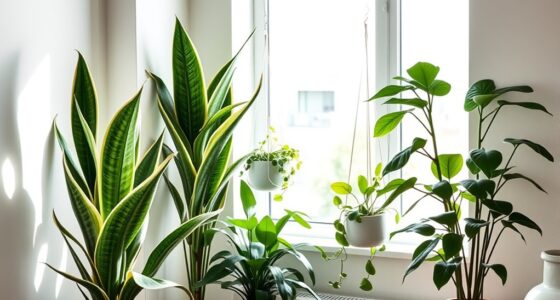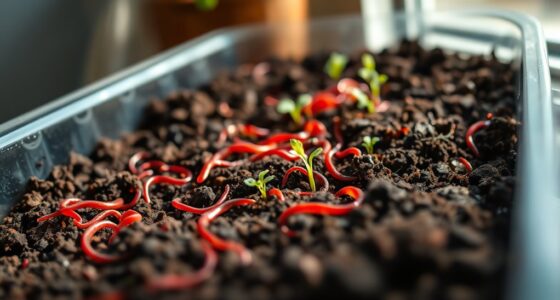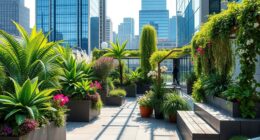To thrive in pots, focus on good soil preparation by choosing quality potting mix and adding organic matter for aeration and moisture retention. Make certain proper drainage by using pots with holes and avoiding overwatering. Maintain pest control by inspecting plants regularly, keeping containers clean, and promoting airflow. These steps lay a healthy foundation, making your container garden more resilient. Keep these tips in mind to open more secrets for vibrant, thriving plants in your pots.
Key Takeaways
- Select high-quality, well-draining potting mix blended with organic matter for optimal root health.
- Ensure proper drainage by using pots with holes and elevating containers to prevent waterlogging.
- Regularly inspect and manage pests using natural methods, maintaining cleanliness to minimize infestations.
- Avoid overcrowding to improve air circulation, reduce humidity, and prevent pest and disease issues.
- Monitor soil moisture and water only when the top inch feels dry to promote healthy plant growth.

Container gardening offers a versatile and accessible way to grow plants, whether you have limited space or want to add greenery to your outdoor or indoor areas. One of the most critical steps in ensuring your plants thrive is proper soil preparation. Start by choosing a high-quality potting mix designed for container gardening, as it provides the right balance of drainage and nutrients. Avoid using garden soil directly in pots, as it can become compacted and hinder root growth. Instead, blend your potting soil with organic matter like compost or peat moss to improve aeration and moisture retention. This preparation creates an ideal environment for roots to establish, promotes healthy growth, and helps prevent issues like waterlogging or nutrient deficiencies.
Pest management is another essential aspect of successful container gardening. Containers can attract pests such as aphids, spider mites, or fungus gnats, which can quickly damage your plants. To minimize pest problems, inspect new plants thoroughly before introducing them to your containers. Keep your containers clean by removing fallen leaves or debris that can harbor pests and disease. Incorporate natural pest control methods such as introducing beneficial insects like ladybugs or using organic insecticidal soap if you notice an infestation. Good air circulation is crucial; avoid overcrowding plants, as dense foliage can create a humid environment that favors pests and diseases. Regularly monitor your plants for early signs of pest activity and take prompt action to prevent a small problem from escalating.
Additionally, ensuring your containers have proper drainage is paramount to pest management. Use pots with drainage holes and position them on feet or stands to prevent water from stagnating at the bottom. Overwatering not only harms plant roots but also creates ideal conditions for pests and fungi to thrive. Water your plants only when the top inch of soil feels dry, and always check that excess water can escape freely. Incorporating good soil preparation with vigilant pest control creates a healthy foundation for your container garden. It reduces the chances of pests taking hold and promotes vigorous, disease-resistant plants. When you start with the right soil and stay attentive to pest issues, you’ll enjoy a lush, thriving container garden that adds beauty and freshness to your space with less effort and frustration.
Frequently Asked Questions
How Do I Prevent Pests in Container Gardens?
To prevent pests in your container garden, start by choosing pest-resistant plants that naturally deter bugs. Regularly inspect your plants for signs of pests and remove any affected leaves. Use natural pest control methods like introducing beneficial insects or applying organic sprays, avoiding harsh chemicals. Keep your containers clean and avoid overwatering, which can attract pests. These steps create a healthy environment where pests struggle to thrive, keeping your garden thriving.
What Are the Best Fertilizers for Container Plants?
You want the best fertilizers for your container plants, so consider organic options like compost tea, fish emulsion, or seaweed extract. These provide essential nutrients and improve soil health. Adding soil amendments such as worm castings or organic matter boosts plant growth. Always choose a balanced fertilizer with nitrogen, phosphorus, and potassium, and apply it according to package instructions to keep your container garden thriving and healthy.
Can I Grow Vegetables in Small Containers?
Yes, you can grow vegetables in small containers if you choose the right plant selection. Focus on compact varieties like lettuce, radishes, or herbs. Use composting tips to enrich your soil, ensuring your plants get enough nutrients. Keep in mind that regular watering and proper drainage are essential. With careful attention and the right container size, you’ll enjoy fresh vegetables even in limited space.
How Often Should I Water Container Plants?
Your watering frequency depends on maintaining consistent soil moisture. Check your container plants daily by sticking your finger about an inch into the soil; if it feels dry, it’s time to water. During hot weather, you might need to water more often, while cooler days require less. Always guarantee excess water drains well to prevent root rot. Adjust your watering schedule as needed to keep your plants healthy and thriving.
What Are Some Space-Saving Container Gardening Tips?
Did you know that vertical gardening can save up to 80% of space? To maximize your container garden, choose compact plant varieties and optimize container placement by stacking or hanging pots. Prioritize plants with similar sunlight needs and use wall-mounted or tiered planters. This approach helps you create lush, productive gardens even in small spaces, making gardening accessible and enjoyable regardless of your limited area.
Conclusion
So, congratulations, you’ve officially mastered the art of container gardening. Who knew that struggling with tiny pots and wilting plants could be so rewarding? Now, instead of a boring backyard, you’ve got a jungle of thriving greenery—because nothing says “I’ve got it together” like perfectly curated pots. Just remember, with great plant power comes great responsibility… or at least, a great Instagram feed. Happy gardening, superstar!









